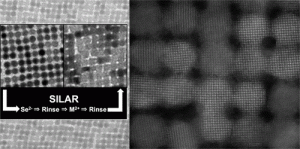 Recent discoveries of the formation of epitaxially connected quasi-two-dimensional quantum dot superlattices have opened new horizons to create novel materials with properties by design. Calculations of such 2D quantum dot solids forecast a rich electronic structure with features such as Dirac cones and topological edge states. However, to date, experimental validation of the properties emerging from the delocalization electrons in these systems is still lacking. Recent studies identified the connections between the dots as a key bottleneck in the localization of electronic states. A key scientific challenge is therefore to understand and control the formation of epitaxial bonds that connect the dots in these assemblies.
Recent discoveries of the formation of epitaxially connected quasi-two-dimensional quantum dot superlattices have opened new horizons to create novel materials with properties by design. Calculations of such 2D quantum dot solids forecast a rich electronic structure with features such as Dirac cones and topological edge states. However, to date, experimental validation of the properties emerging from the delocalization electrons in these systems is still lacking. Recent studies identified the connections between the dots as a key bottleneck in the localization of electronic states. A key scientific challenge is therefore to understand and control the formation of epitaxial bonds that connect the dots in these assemblies.
Ben’s paper reports how successive ionic layer adsorption and reaction (SILAR) treatment can form new connections between dots and strengthen the bonds during the initial epitaxial attachment to enhance interdot coupling. Specifically, we show that inter-dot connectivity increases from 82 to 91% and increases the bridge width from 3.1 to 4.0 nm. Our field-effect charge transport measurements confirm a systematic increase in conductance and hole mobility with increasing SILAR growth. Collectively, our structural, optical, and electronic characterization indicates that the properties of the quantum dot solids can be tuned through control of the inorganic interdot bonds without sacrificing the long range order of the assembly.
Treml, Benjamin E., et al. “Successive Ionic Layer Absorption and Reaction for Post-Assembly Control over Inorganic Inter-Dot Bonds in Long-Range Ordered Nanocrystal Films.” ACS Applied Materials & Interfaces (2017).
http://pubs.acs.org/doi/abs/10.1021/acsami.7b01588

